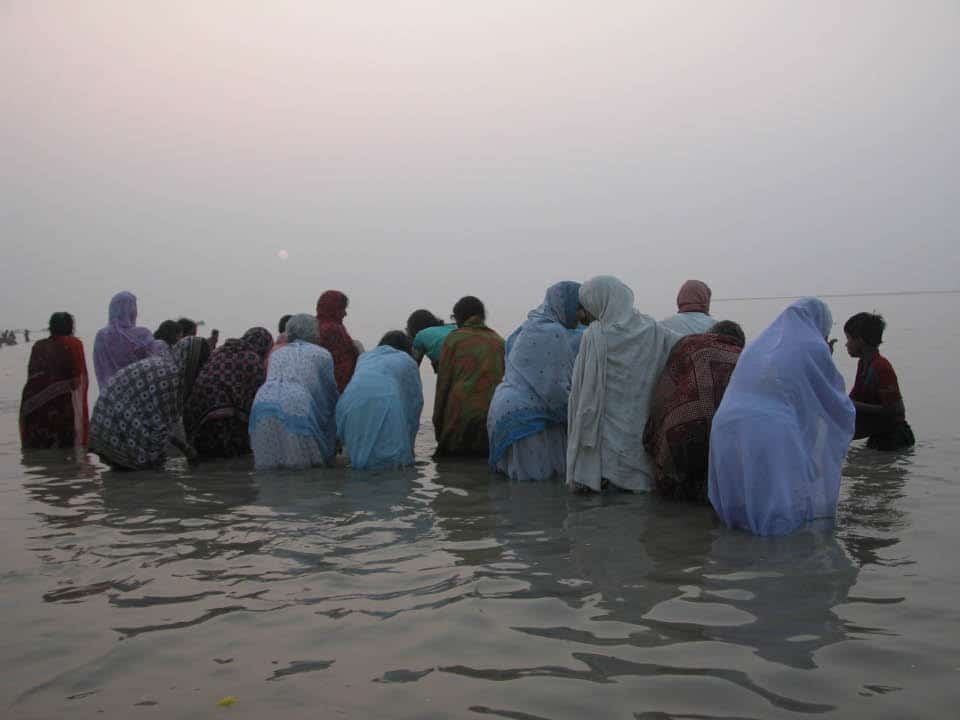As the morning sun rises on Sagar Island’s horizon, hordes of devotees make a beeline for holy dips in the waters of Gangasagar.
For centuries, pilgrims have been thronging to Gangasagar, an island in the Sunderbans in West Bengal, on the estuary of the river Ganges at the confluence of the Ganges and the Bay of Bengal, to wash away their paap (sins), earn punya (virtue), and attain moksha (liberation). Legend has it that 60,000 burnt sons of King Sagar attained salvation at this very spot from the waters of Ganga. They had been reduced to ashes by the fiery look of Kapil Muni for disturbing his meditation.

Manoj crawls in search of mokshaIn 1727 Capt. Alexander Hamilton of the East India Company who was visiting Sagardweep, reported a large number of people taking dips in Gangasagar. Nearly three centuries later, in January on Makar Sankranti nearly a million people from as far as Canada, Nepal, Australia, New Zealand, Bangladesh, Mayanmar, Sri Lanka, USA, England, Mauritius, Fiji and of course all over India descended upon Gangasagar for the largest annual ritual in West Bengal.
Come All Yee Faithful
Faith may reign supreme among the millions of followers who have made a pilgrimage to Gangasagar. However, ironically, Kapil Muni around whose legend Gangasagar emerged, was arguably the first Indian atheist as the founding head of Samhkya, one of six schools of classical Indian philosophy, which questions the existence, evidence and relevance of God. Kapil Muni argued, “Nothing should be accepted without evidence,” and asserted that there are only three ways to know anything: perception, inference and testimony.

Bhola plays with his grandad’s hair
His exhortations notwithstanding, dreams of moksha lure hundreds of thousands to Gangasagar every year. Devotees like Bholaram, who does not know what paap, punya or moksha are, much less anything about Kapil Muni. But he had been coming here every year since he was two years old.
His Dadaji, Tularam, with whom he makes his annual pilgrimage on Makar Sankranti, however, knows the meanings and intricacies behind the rituals. Tularam believes that as a result of his bad karma in his previous birth, Bhola’s parents and his “Dadiji” died in a road accident in Jodhpur in Rajasthan.
Unlike Bhagirath who brought Ganga to earth at Sagar Island to give moksha to 60,000 sons of King Sagar, Tularam cannot bring Bhola’s parents and his “Dadiji” back to life, so he brings his grandson Bhola perched on his shoulder instead. Bhola often plays with Dadaji’s head with his fingers while roaming around Sagar Island, but Tularam does not seem to mind.

Ratan Singh Walia: If I can fly deom Vancouver with my crutches evry year, why can’t people come here from different parts of India.
Ganga Devi has attended every Makar Sankranti since 1960, one year after her husband Ramcharan Bhadoria was gunned down by dacoits in Chambal in the Morena district of Madhya Pradesh on suspicion of being a police mukhbir (informer). Mukhbirs don’t survive in Chambal even today.
Devi is convinced that her past life’s bad karma caused Ramcharan’s death and is confident that Kapil Muni, an avtar of Lord Vishnu, would offer her moksha.
Moksha seemingly torments all those thronging Gangasaga
Devi does not know her age. Her father often said that 15-years before her birth he had given a salam (salute) to King George V and Queen Mary when they attended Delhi Durbar in 1911, marking the transfer of the imperial capital from Calcutta to Delhi. Serving in the British Army at the time, he was the only person from Sumawali hamlet of Morena to salute the British monarch. The wrinkles on Ganga’s face mutely corroborate her age.
Gangasagar Bar Bar

This is one really holy cow. They are given special fodder and never made to plough the field or push a loaded cart.“Sab tirath bar-bar, Gangasagar ek bar” (you can visit other pilgrimages repeatedly, but coming to Gangasagar is possible once only). This centuries old saying irritates 77-year-old Ratna Singh Walia, “If I can fly from Vancouver with my crutches every year, why cannot people come here from different parts of India?”
Every January, she comes to Gangasagar from Canada. After a holy dip, she heads to Kolkata to meet relatives and enjoy sarson da saag, makke di roti and some mouth-watering rosogolla. Her daughter Roop Chadha relishes mishti doi (sweet curd), which she is hard pressed to find in Canada. “If they open Mishti Doi stores in Vancouver, Ottawa, Ontario or any other Canadian city, it would do brisk business, people would line up to buy, you have my word. Oh! Mishti Doi, so delicious,” Chadha coos.
It isn’t just humans who troupe to Gangasagar, however. Calves and cows also undertake ritualistic puja ceremonies and doobki (dip) in its waters.
Devotees from Haryana, where Kapil Muni is considered to have established his Samkhya philosophy, and Rajasthan, where he is thought to have performed his tapasya, bring their cows to Gangasagar for moksha. Back home, they enjoy special status within their animal community for having taken a doobki in Gangasagar. They are given special fodder and never made to plough the field or push a loaded cart.
Such are the wages — and rewards — of moksha.
Photos: Prasenjit Home Chowdhury

